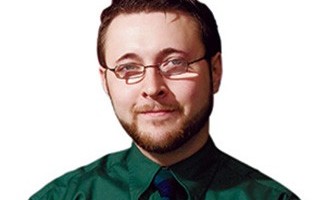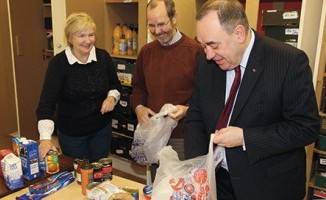Ewan Gurr, Scotland development officer from The Trussell Trust on why even the richest areas now need foodbanks.

IT was 24 years ago that I set foot on the beautiful island of Orkney for the first time, and at the end of last year, I had the opportunity to return. This time, I discovered what a windy day really feels like, that hailstones the size of golf balls really do exist and that it is possible for a man to simultaneously possess a name like Robert Bruce Donald and a strong Canadian accent. However, the greatest shock of all was that I travelled back to the second wealthiest local authority in Scotland to help establish a foodbank.
At the outset of any presentation or training session I share a bit about the work of The Trussell Trust and describe what we define as a foodbank. In over eight years of working in the area of emergency food provision, I have heard the term used to describe anything from a handful of tins in a church cupboard to a tonne of perishable foodstuffs only fit for landfill (or poor people).
Many are now exposed to Chinese whispers regarding how often someone can use a foodbank, the voucher referral system and whether or not foodbanks have any role in addressing the underlying causes of food poverty. I, therefore, find highlighting our aims and creating a visual image in the mind of the volunteer to be a crucial step in the journey to dislodge some of the negative myths that exist.
Recently, I read a newspaper article about a man called Nick Saul who took over the running of a foodbank in Canada and has changed, adapted and developed the project to such an extent it has attracted widespread media attention and is virtually unrecognisable compared to where it began. In his book The Stop, Nick described a visit to his original foodbank as “a slow, painful death of the spirit – forcing yourself to visit a crowded, ill-equipped, makeshift place, answer personal questions, swallow your pride as you wait in a line only to be offered bizarre processed food products or slimy wilted lettuce that couldn’t be revived with electric shock treatment…”
In December alone, our 43 foodbanks provided emergency food relief to over 6,500 people
As I finished reading aloud this quote at the training session for the volunteers of Orkney foodbank, I looked up and explained that sometimes understanding what a foodbank isn’t is key to grasping what a foodbank is. In the last two years, I’ve overseen the launch, training and public opening of over 40 foodbanks in Scotland and if any of them looked anything like Nick described, I would be submitting my resignation letter and taking a walk to the Job Centre.
When I finished talking, I saw a lady sitting in the front row who was visibly moved. As we opened up for interaction, she began to speak with a strong American accent.
Michelle told the group she was in the United States military until an injury rendered her incapable of sustaining the post. She was living in Alaska in 2003 and the cost of living plunged her into a downward spiral that forced her to steal toilet paper from the university, wash her clothes in the shower and endure hunger pains that lasted for days. Eventually, she was at the door of a foodbank similar to the one described and it was a the pleasant experience.

However, rather than fermenting a spirit of contempt, the experience has led Michelle to faithfully volunteer.
“Here, it is like walking into someone’s living room,” she says. “It’s clean, dignified, warm and homely. People feel safe.”
Orkney foodbank reached 45 people in its first month of operation and Michelle talks fervently about some of the people she has met.
The first man Michelle met came in with an air of trepidation but sat with a coffee and biscuits and within minutes was sharing his story, talking about his children, his working life and the situation he had found himself in.
She said: “That man left knowing what he needed to do to get his situation sorted. No stone was left unturned by the volunteers, but they were conversational rather than clinical. He left feeling human again and you could see in his demeanour that the burden had lifted and hope was reignited within him.”
December 2013 saw the busiest month in the history of The Trussell Trust in Scotland as our 43 foodbanks provided emergency food relief to over 6,500 people; a third of which were children.
It is also a time of year that evokes the warmth of human kindness as over 105 tonnes of food were generously donated by the public. Only too often those most selfless donors are the people who also feel the pinch of the rising cost of living and static incomes.
However, it is crucial while attempting to tackle food poverty practically that we ask questions about the policies that create it. We have seen cross-party support in Scotland throughout 2013 and in the last month Scottish first minister Alex Salmond visited one of our Edinburgh foodbanks to deliver a Scottish Government report about emergency food provision in Scotland. The following day, foodbanks were debated in the House of Commons and numerous elected officials shared personal stories about the impact of current welfare reforms and minimal employment opportunities they are seeing in their constituencies.
There is still more to be done, but if we can continue to highlight the extent of food poverty and share our stories of hidden hunger, perhaps the search for creative solutions will emerge as a result of those conversations.






